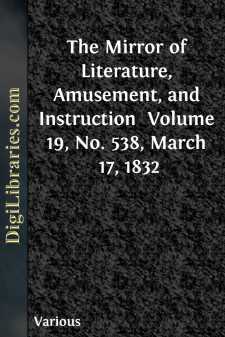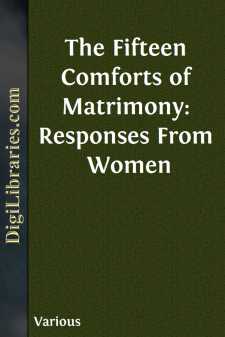Categories
- Antiques & Collectibles 13
- Architecture 36
- Art 48
- Bibles 22
- Biography & Autobiography 813
- Body, Mind & Spirit 142
- Business & Economics 28
- Children's Books 17
- Children's Fiction 14
- Computers 4
- Cooking 94
- Crafts & Hobbies 4
- Drama 346
- Education 46
- Family & Relationships 57
- Fiction 11829
- Games 19
- Gardening 17
- Health & Fitness 34
- History 1377
- House & Home 1
- Humor 147
- Juvenile Fiction 1873
- Juvenile Nonfiction 202
- Language Arts & Disciplines 88
- Law 16
- Literary Collections 686
- Literary Criticism 179
- Mathematics 13
- Medical 41
- Music 40
- Nature 179
- Non-Classifiable 1768
- Performing Arts 7
- Periodicals 1453
- Philosophy 64
- Photography 2
- Poetry 896
- Political Science 203
- Psychology 42
- Reference 154
- Religion 513
- Science 126
- Self-Help 84
- Social Science 81
- Sports & Recreation 34
- Study Aids 3
- Technology & Engineering 59
- Transportation 23
- Travel 463
- True Crime 29
The Mirror of Literature, Amusement, and Instruction Volume 19, No. 538, March 17, 1832
by: Various
Categories:
Description:
Excerpt
THE ARBALEST, OR CROSS-BOW.
THE ARBALEST, OR CROSS-BOW.
The Bow would appear to have been in most ancient nations the principal implement of war; and to keep alive this "mystery of murder," archery, or the art of shooting with a bow and arrow, seems to have been a favourite pastime in days of peace. In no country, however, has archery been more encouraged than in this island; wherefore the English archers became the best in Europe, and procured many signal victories. Tributary as have been the bow and arrow to some of the brightest scenes in our history, it is not surprising that its exercise should have become cherished among us as an amusement. Strutt tells us that in the early ages of chivalry, the usage of the bow was considered as an essential part of the education of a young man who wished to make a figure in life. Hence the long-bow and cross-bow have been and are playthings in the hands of youth; and would that they had only been the toys of the playground instead of leading men to slaughter each other for the costly toys of the game of life. It is chiefly to the use of the cross-bow that we propose to confine ourselves upon the present occasion.
The arbalest, or cross-bow, was not only much shorter than the long-bow, but fastened also upon a stock, and discharged by means of a catch or trigger, which Mr. Strutt reasonably enough thinks gave rise to the lock on the modern musket. The old logicians illustrate the distinction in their quaintest fashion. Bayle, explaining the difference between testimony and argument, uses this laconic simile, "Testimony is like the shot of a long-bow, which owes its efficacy to the force of the shooter; argument is like the shot of the cross-bow, equally forcible, whether discharged by a dwarf or a giant."
The arbalest is said by some writers to be of Italian origin. Verstegan says it was introduced here by the Saxons, but was neglected till again brought into use by William the Conqueror, at the battle of Hastings. No mention is made of bowmen among the troops of Harold; but we read that the Norman army was fronted by "footmen clothed in light armour, worn over a gilted cassock, and bearing either long-bows or steel cross-bows." Harold himself had his eye struck by an arrow, notwithstanding which he continued to fight at the head of his army. Cross-bows were afterwards prohibited by the second Lateran Council, anno 1139, as hateful to God, and unfit to be used among Christians; in consequence whereof they were laid aside till the reign of Richard the First, who again introduced them, and was himself killed by an arrow or quarrel, discharged from a cross-bow at the siege of the Castle of Chalus.
Cross-bows shot darts called quarrels, or quarreaux, or quadrels, and in English bolts: they were headed with solid, square pyramids of iron, and sometimes trimmed with brass instead of feathers. According to Sir John Smith a cross-bow would kill point blank 60 yards, and if elevated above 160. There was an officer styled Balistrarius Regius; and several estates were held by the service of delivering a cross-bow and thread to make the string, when the king passed through certain districts....












